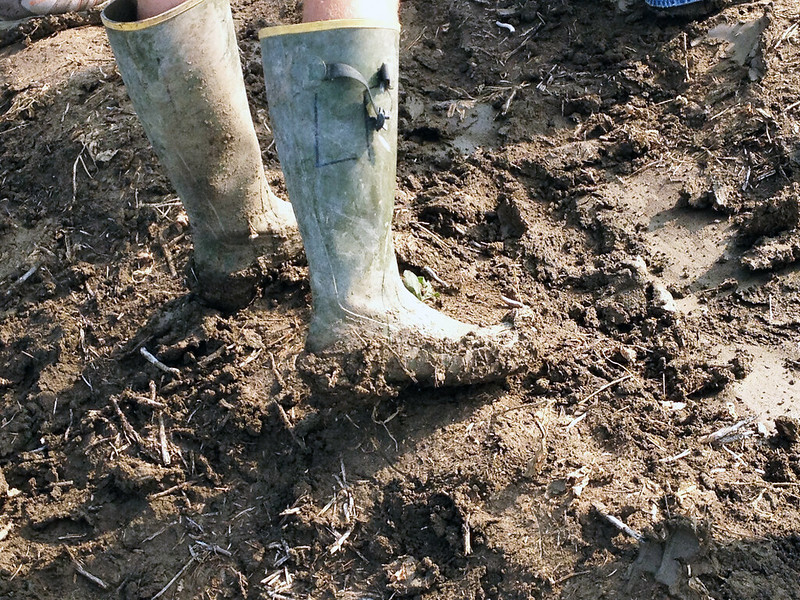March 12, 2021
Wet weather offers challenges for cow and calf health
By the U of A System Division of Agriculture
Fast Facts:
- Snowfall and other wet conditions have left many Arkansas pastures muddy
- Cattle producers should take additional measures to ensure the health of cows and calves in these conditions
(645 words)
FAYETTEVILLE, Ark. — After this winter’s freeze and thaw coupled with the recent rains, many Arkansas landowners have seen their pastures transform into vast acres of mud.
Dirk Philipp, associate professor of animal science for the University of Arkansas System Division of Agriculture, said that wet weather brings with it many challenges for cattle producers.
Although the state has had a chance to dry out after the heavy February snow, portions of Arkansas could see 1-3 inches of rain through the weekend, according to the National Weather Service.
“Cattle are less able to stay warm, may suffer injuries when walking through deep mud, and, of course, we notice now more than ever the tell-tale signs of lameness due to foot rot and abscesses,” Philipp said.
Some challenges, he said, include mud and manure collected around water troughs, feeding areas and areas where cows bed down; cows tending to congregate more in feeding areas, watering areas, and near gates, and more.
“We tend to place troughs near fence lines where we can access them easily, further leading to muddy pits and congregating areas,” Philipp said.
Other challenges associated with raising cattle in muddy conditions include:
- Frozen mud can cause sharp edges, increasing the risk of abrasions to hooves and skin of the interdigital space and increasing the risk of injury during late pregnancy and calving.
- Wet conditions after thaw make a cow’s hooves and the skin softer, allowing bacteria to enter via abrasions or injuries.
- Bacterial infection between the claws of the toes (foot rot) can cause cattle to present as suddenly lame.
- Foot rot organisms, such as Fusobacterium necrophorum, are naturally present in most environments. Incidence of rot typically increase in wet, muddy pastures and areas where fecal matter tends to collect.
- The risk of developing foot rot is increased during late pregnancy and into calving due to increased stress on the immune system.
- Calves born in wet, muddy conditions with a heavy manure load may begin nursing from overly dirty udders, ingesting harmful pathogens and leading to scours, which is potentially deadly for newborns.
- Calves are more susceptible to navel ill, also known as joint ill, a disease sometimes found in young calves.
- Even if calves survive, a more stressed or challenged immune system leads to fewer gains and decreased overall performance.
- Muddy pastures tend to feature increased incidence of coccidia and cryptosporidia — both common protozoans spread by manure — infections.
Sarah Shelby, a research associate with the Division of Agriculture working with Philipp, said that despite these many risks, they are manageable.
“A proactive approach in management practices during this season can have significant pay offs in animal health, less labor pulling in and treating lame animals, and more pounds on the scale at weaning due to healthier cows with increased lactation and healthier calves with more gain per day of age,” Shelby said.
She said there are many potential solutions to the problems caused by muddy environments, including moving feed bunks and round bales feeders and rolling out round bales in different areas to minimize muddy conditions, preferably on uphill areas.
Other approaches include:
- Placing feed bunks on concrete slabs whenever possible to reduce cows standing in mud and manure.
- Moving water troughs often, if possible.
- For flat pastures, building up mounds with a slope of approximately 3 to 5 percent and rebuilding annually.
- Avoiding feeding near entry gates or fence lines, where cows will tend to congregate.
- Using extra bedding in calving lots and bedding down often.
- Using uphill, drier pastures during calving.
- Using electrified high tensile wire to temporarily fence off larger, low-lying areas where mud and water accumulates or around any boggy areas of the pasture.
- Covering frozen ground or muddy areas with straw.
- Cleaning and bedding down pens often and covering with a layer of lime after cleanout and before laying down more bedding for the next group.
To learn more about extension programs in Arkansas, contact your local Cooperative Extension Service agent or visit uaex.uada.edu. Follow us on Twitter at @UAEX_edu.
About the Division of Agriculture
The University of Arkansas System Division of Agriculture’s mission is to strengthen agriculture, communities, and families by connecting trusted research to the adoption of best practices. Through the Agricultural Experiment Station and the Cooperative Extension Service, the Division of Agriculture conducts research and extension work within the nation’s historic land grant education system.
The Division of Agriculture is one of 20 entities within the University of Arkansas System. It has offices in all 75 counties in Arkansas and faculty on five system campuses.
Pursuant to 7 CFR § 15.3, the University of Arkansas System Division of Agriculture offers all its Extension and Research programs and services (including employment) without regard to race, color, sex, national origin, religion, age, disability, marital or veteran status, genetic information, sexual preference, pregnancy or any other legally protected status, and is an equal opportunity institution.
# # #
Media contact:
Ryan McGeeney
Communications Services
University of Arkansas System Division of Agriculture
Cooperative Extension Service
(501) 671-2120
rmcgeeney@uada.edu
